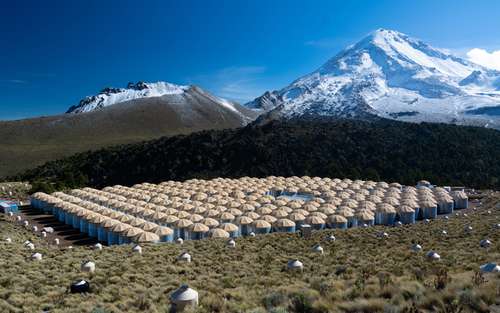Cosmic rays could be linked to mass extinctions of living organisms

▲ On the slopes of the Sierra Negra volcano in Puebla, at an altitude of about 4 thousand meters above sea level, is the Cherenkov Observatory, which instead of antennas contains a group of water tanks.Conahsett photos
Erent Gomez
La Jornada newspaper
Friday, June 14, 2024, p. 6
Cosmic rays are linked to our planet because they produce the northern and southern lights, in addition to their participation in the production of clouds, and some specialists even claim that they may be linked to the mass extinction of living organisms on Earth.
This is what astrophysicist Magdalena Gonzalez Sánchez, a researcher at the Institute of Astronomy of the National Autonomous University of Mexico (UNAM), who specializes in high-energy gamma rays, explained at her conference. Cosmic rays, messengers of the universe
It is taught within the News of the Universe course, organized by the National College.
Like any particle coming from the universe, cosmic rays affect the Earth’s atmosphere, It consists of 86% hydrogen, 12% heavier elements such as helium, and 2 neutrons, neutrinos, and gamma rays.
He said.
Its discovery dates back to 1900, when Theodor Wolff, a German Jesuit priest and physicist, realized that his electroscope – an instrument used to detect the presence and magnitude of electrical charges in an object – They discharge slowly, even when well insulated, indicating the presence of unknown ionizing radiation
.
Austrian physicist Viktor Hess then conducted a series of experiments using hot air balloons to measure radiation at different altitudes, and found that the ionization rate increases significantly with altitude, suggesting that the radiation has an extraterrestrial origin. In 1936, Hess won the Nobel Prize in Physics for his discovery of cosmic rays.
From there, the specialist continued, studies on this energy continued and deepened in the following years with Jacob Clay, who made measurements from the equator to the North Pole and discovered that the Earth’s magnetic field affects it. Bruno Rossi then showed that they do not arrive uniformly from all directions, and determined how they interact with the Earth’s atmosphere, producing cascades of secondary particles.
González Sánchez, initiator and collaborator of the High Water Gamma-Ray Observatory (HAWC), located on the Sierra Negra volcano in Puebla, considered that asking the question: where do cosmic rays originate from is the same as saying: where do they originate? The elements that make up ordinary matter arise: we observe them, with what we were created, and with what we interact with them?
Particle detection
This energy arises from supernova explosions, black holes, and solar events, which makes it contain heavy elements such as iron, nickel, chromium, manganese, and cobalt. Then, by interacting with the interstellar medium, they produce secondary elements, such as lithium, beryllium, and boron.
The doctor in physics from the University of Wisconsin said that the importance of studying cosmic rays has scientific, technological and practical implications in various fields.
In the case of technology, it is estimated that these particle detectors have led to the development of advanced radiation monitoring and particle detection techniques. In the scientific field, international and interdisciplinary cooperation is strengthened, uniting scientists from various fields such as astrophysics, physics, engineering and meteorology.
In terms of their interaction with the Earth’s atmosphere, cosmic rays can have effects on climate, cloud formation, and be the source of lightning.
In Mexico, cosmic rays are studied from the HAWC telescope, which is located at an altitude of 4,000 meters above sea level. Its infrastructure is designed to detect Cherenkov radiation resulting from cascades of secondary particles generated when cosmic rays and gamma rays interact with the Earth’s atmosphere.
Instead of antennas, it has a group of water tanks distributed over an area of approximately 22 thousand square meters. Inside each tank, one or more photomultipliers are mounted at the bottom. These devices are sensitive to Cherenkov light and convert the detected photons into electrical signals; This is how scientists monitor cosmic rays and gamma rays at the highest energies.
HAWC telescope It is one of the most important tools we have to further study these particles. His contributions include mapping large regions of the sky in search of high-energy gamma-ray sources, but he also identified and characterized many galactic and extragalactic sources of gamma rays and contributed to the study of supermassive black holes, active galactic nuclei, and pulsars. .
concluded Gonzalez Sanchez.

“Creator. Troublemaker. Hardcore alcohol lover. Web evangelist. Extreme pop culture practitioner. Devoted zombie scholar. Avid introvert.”
